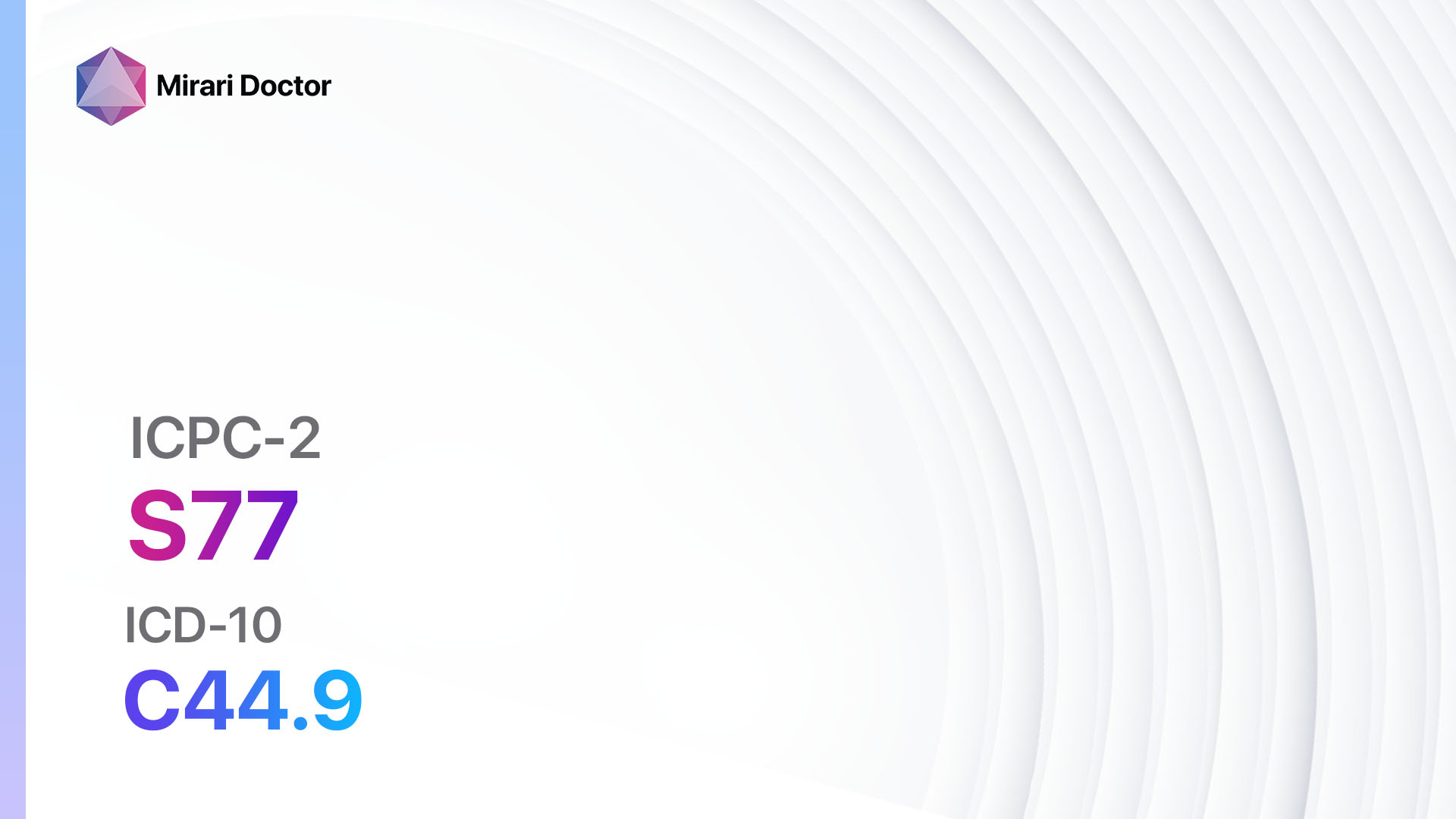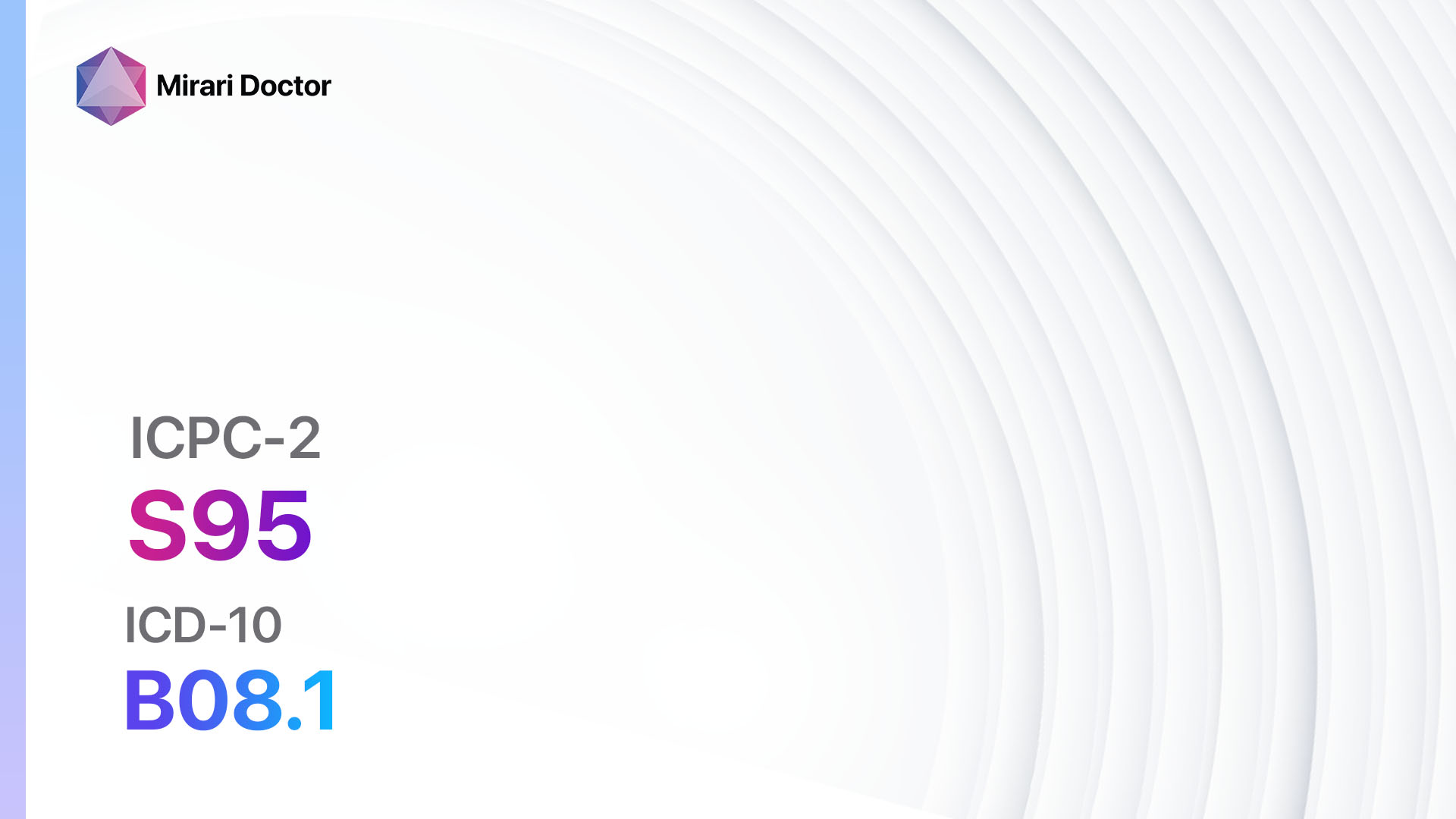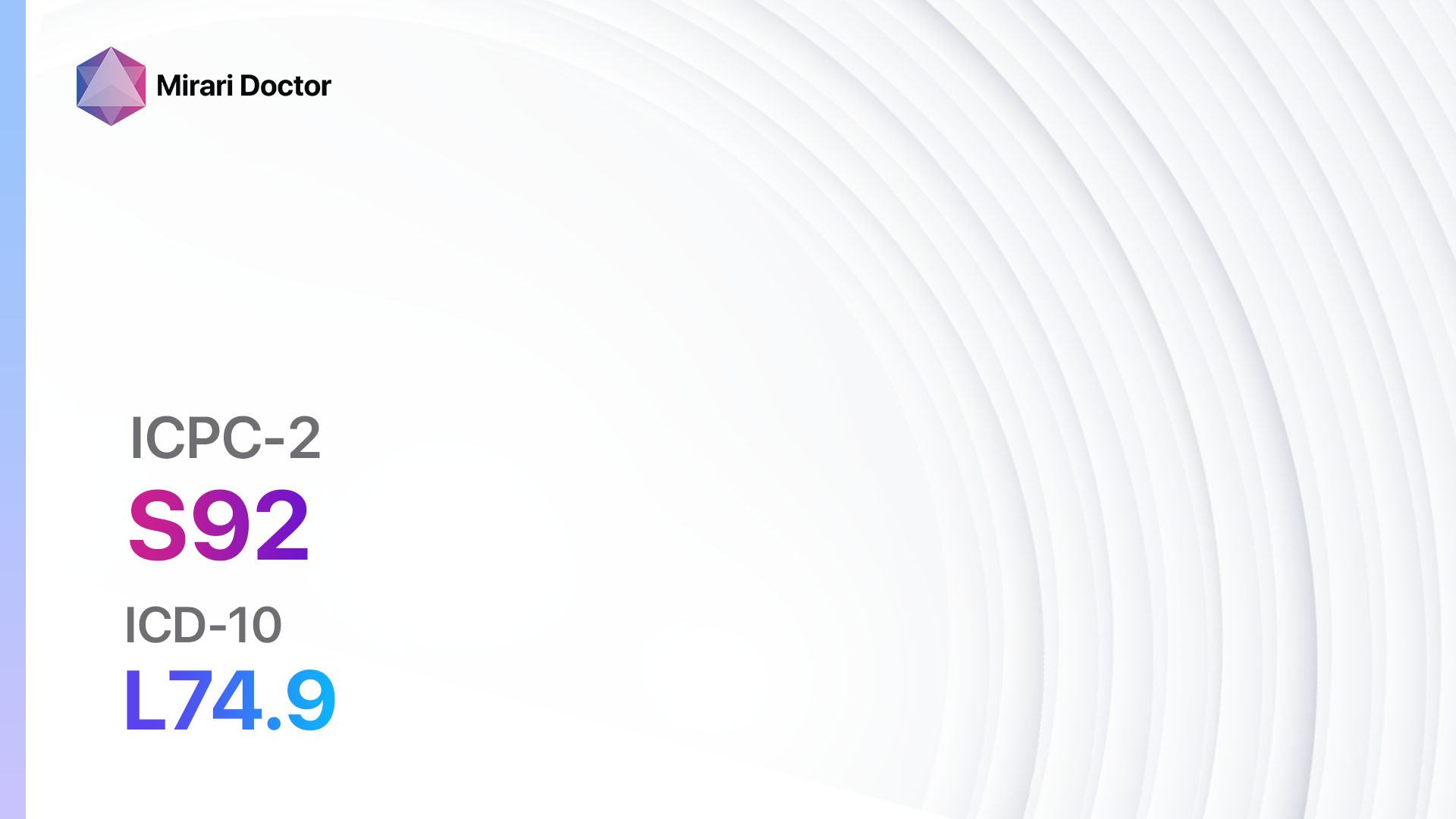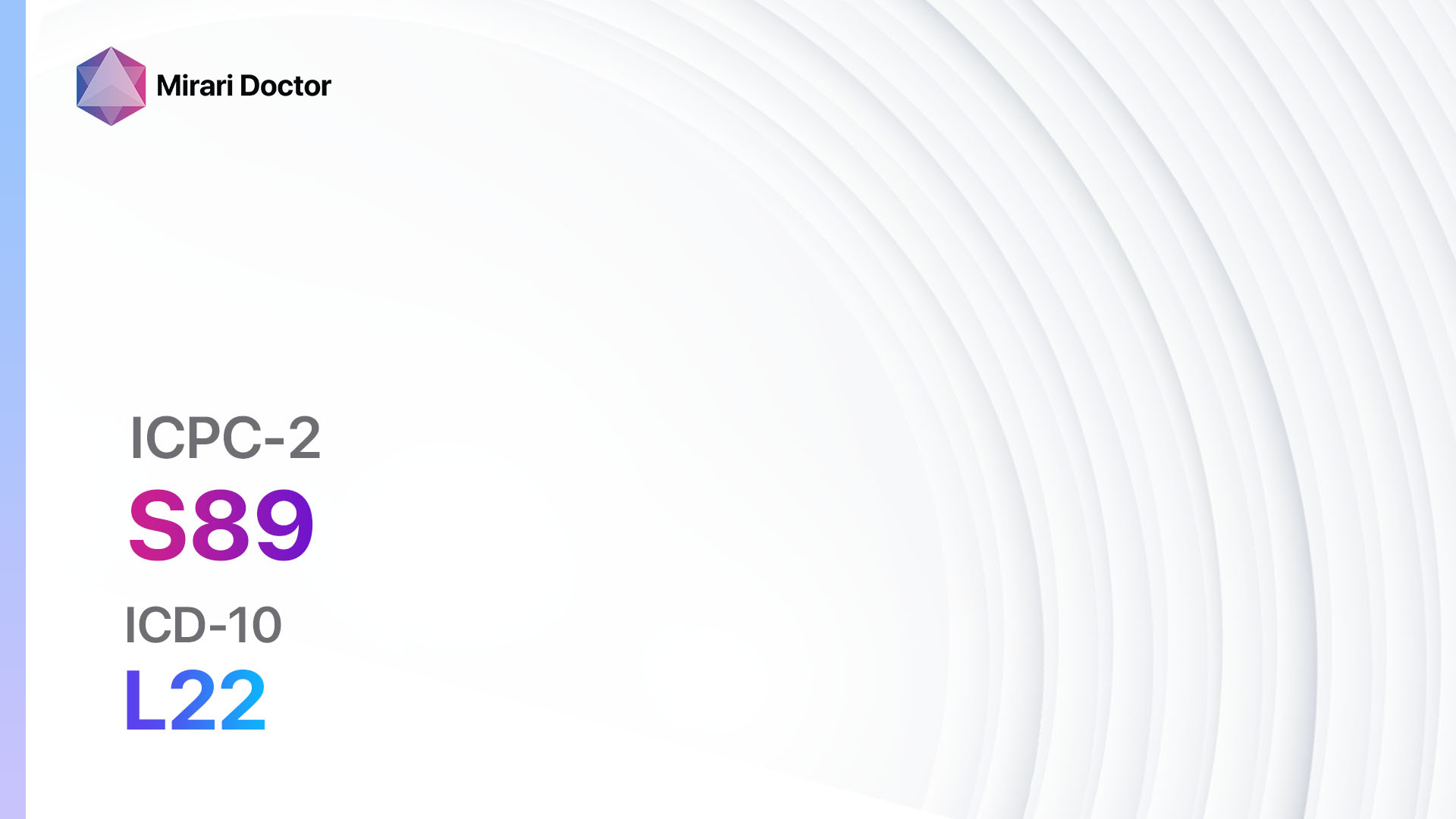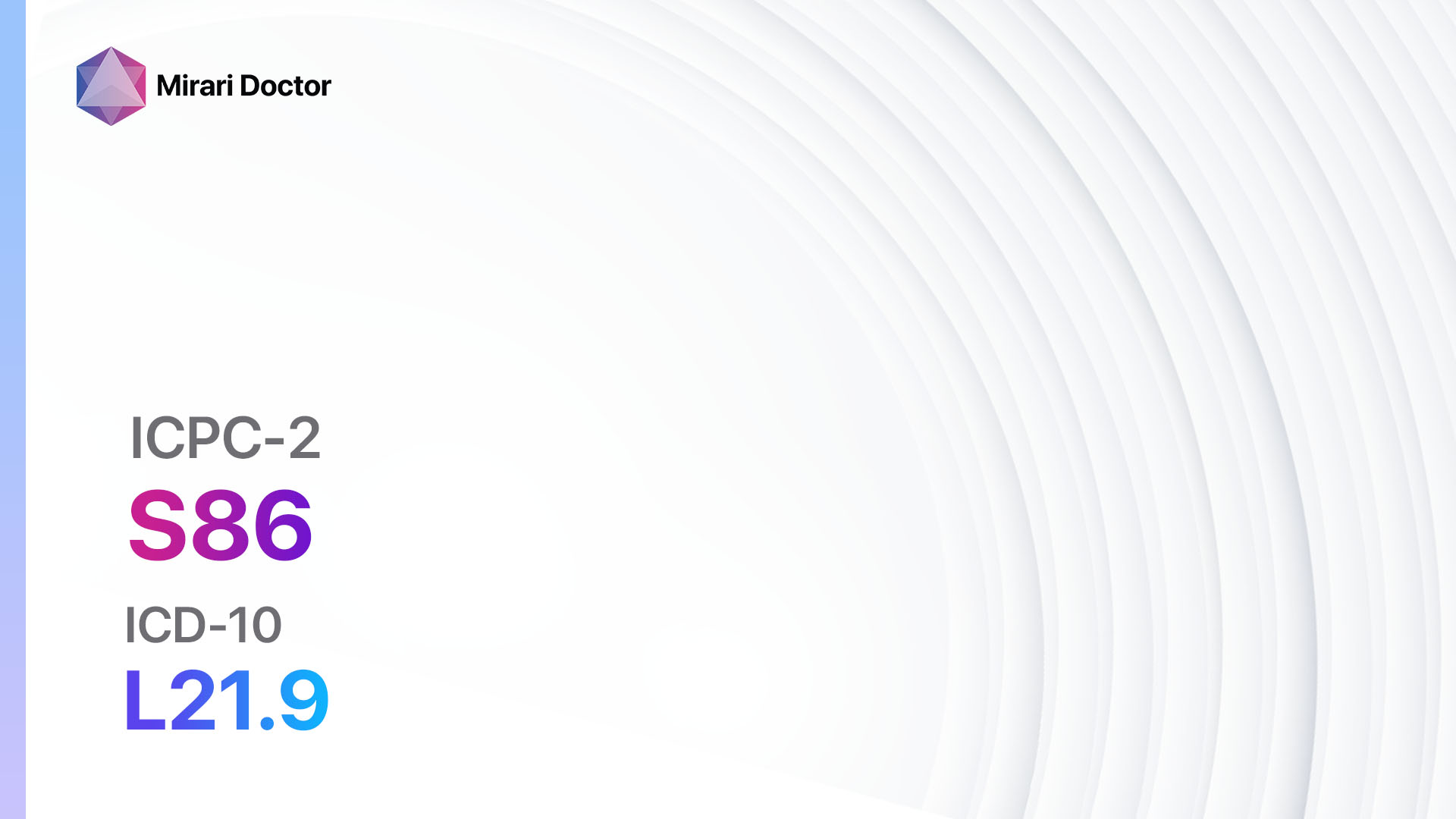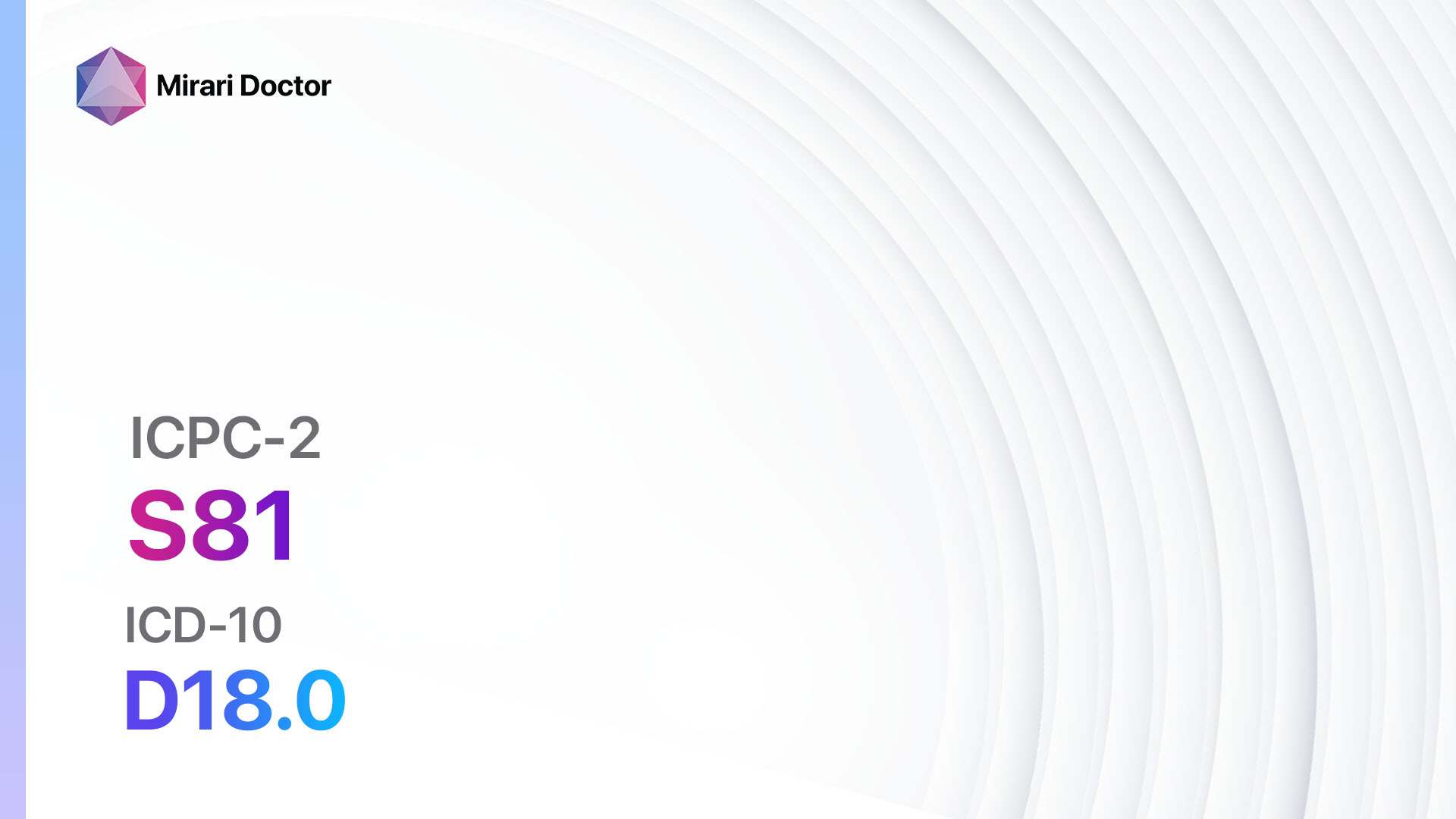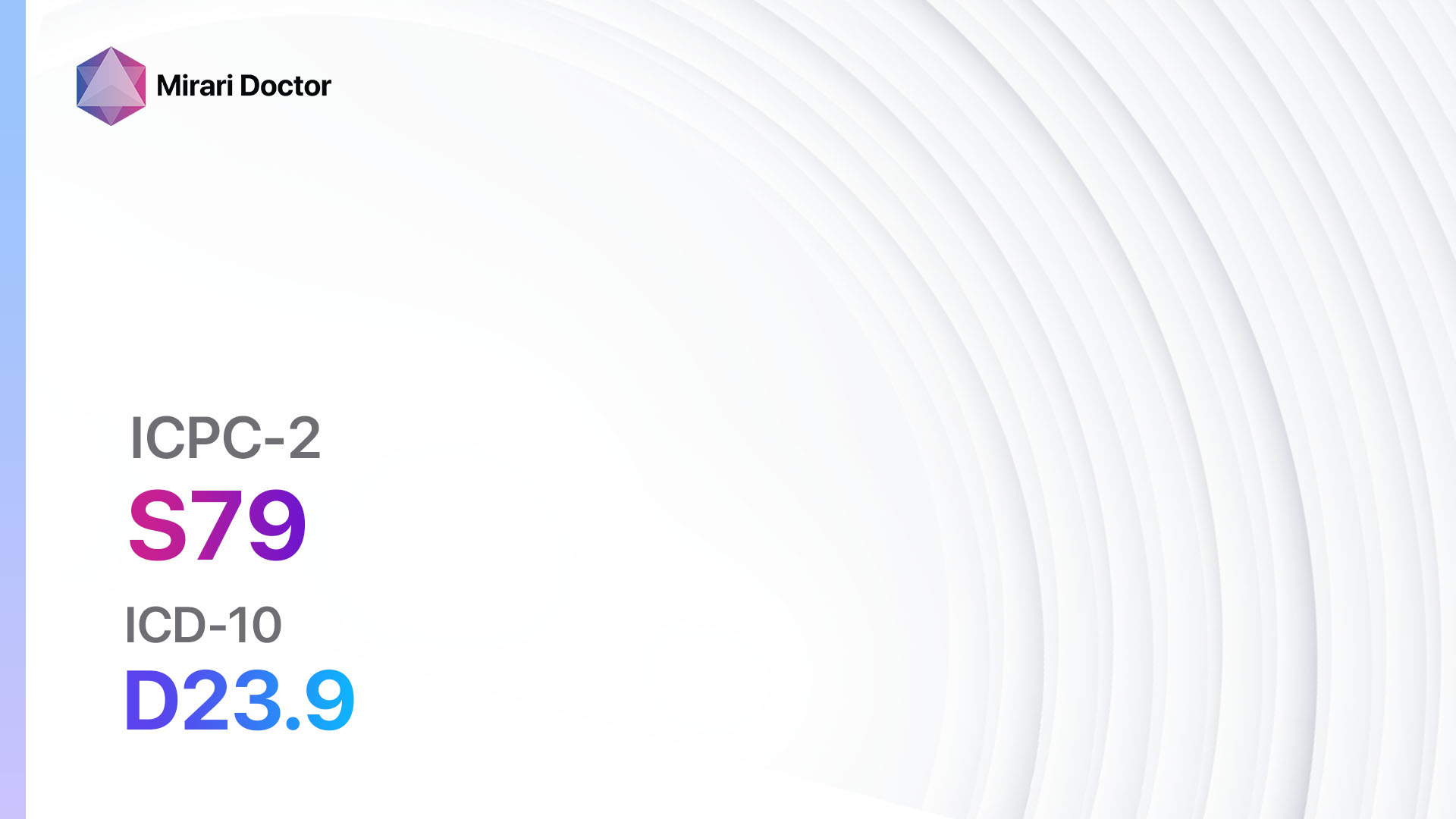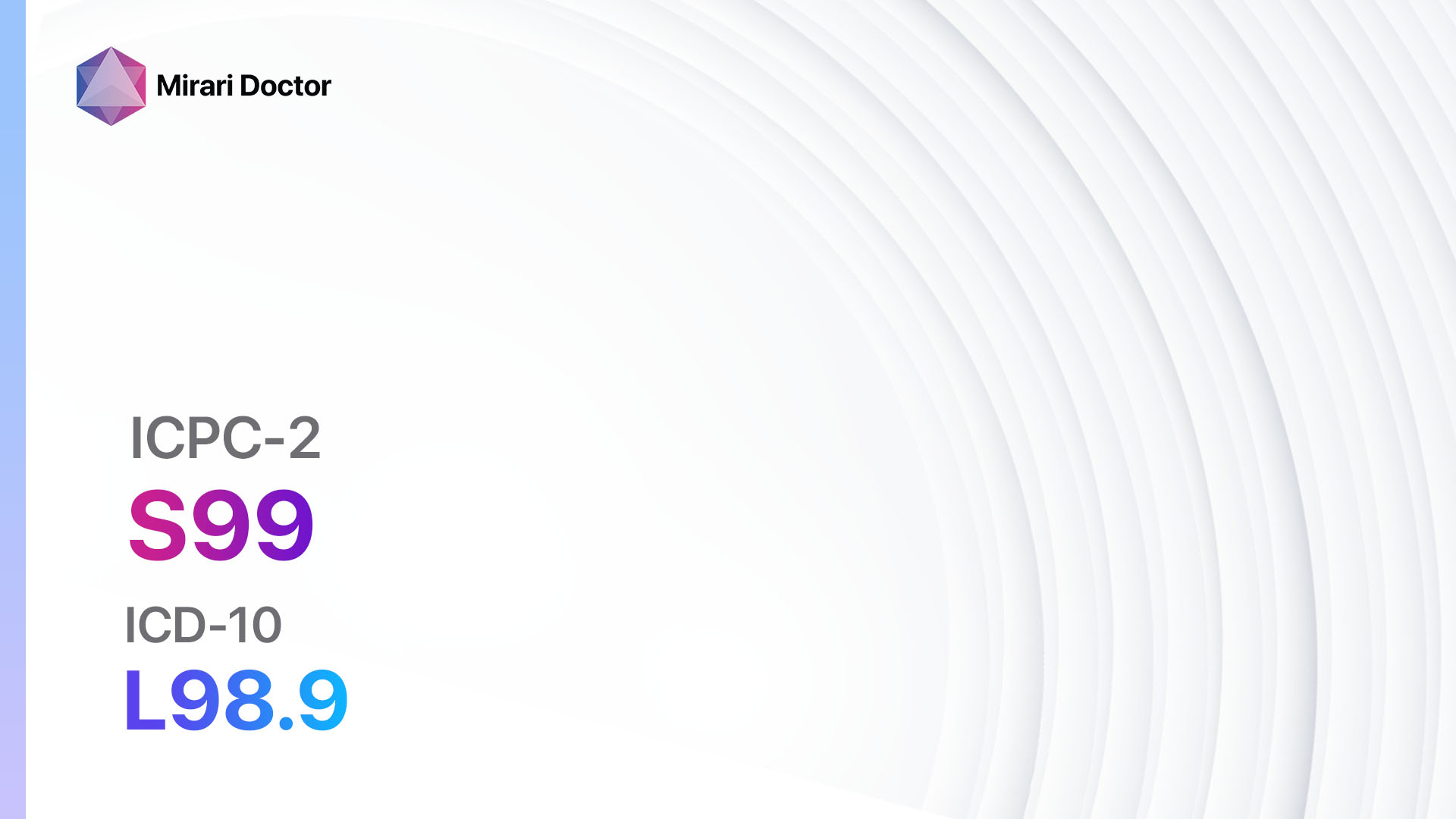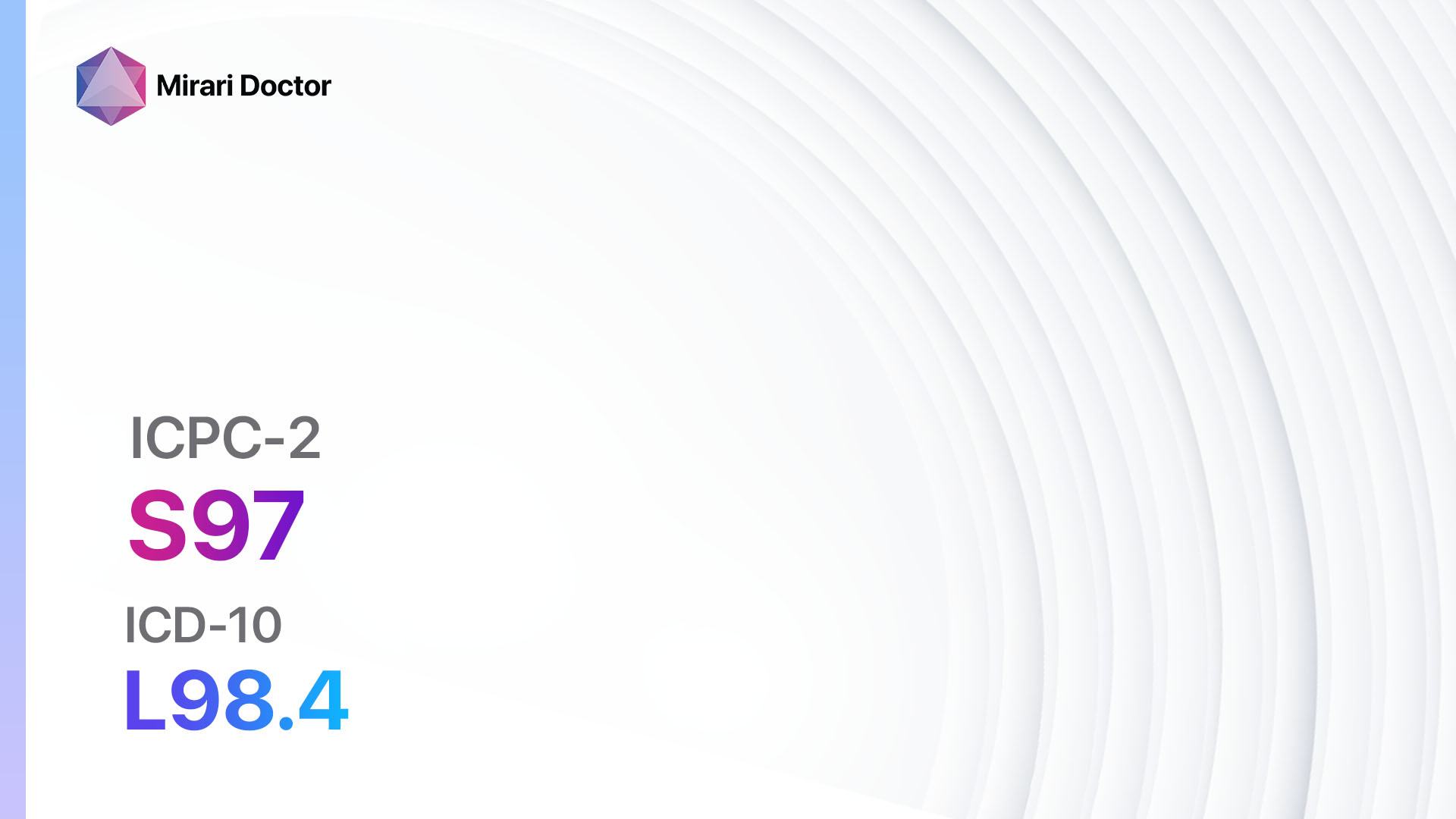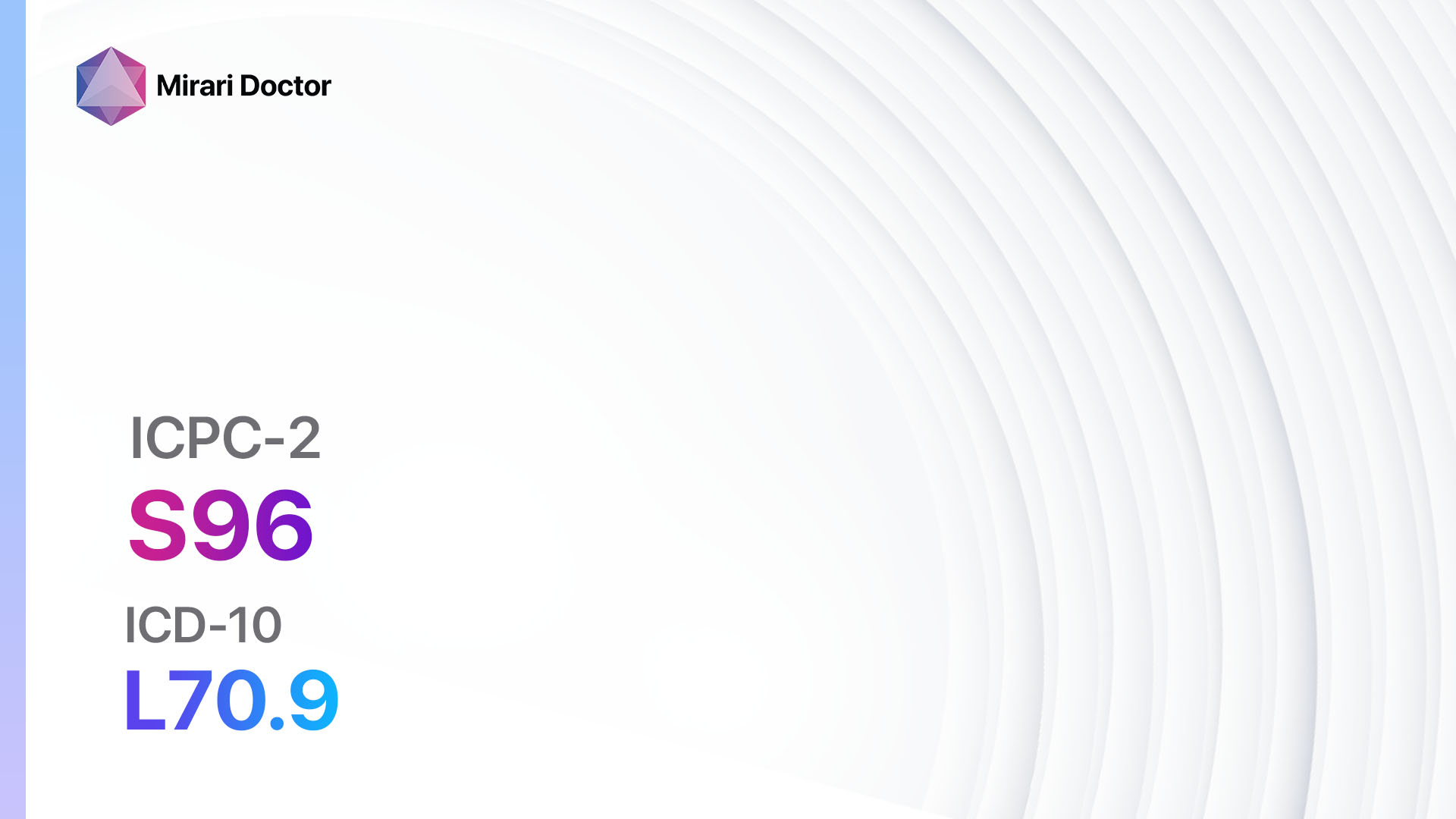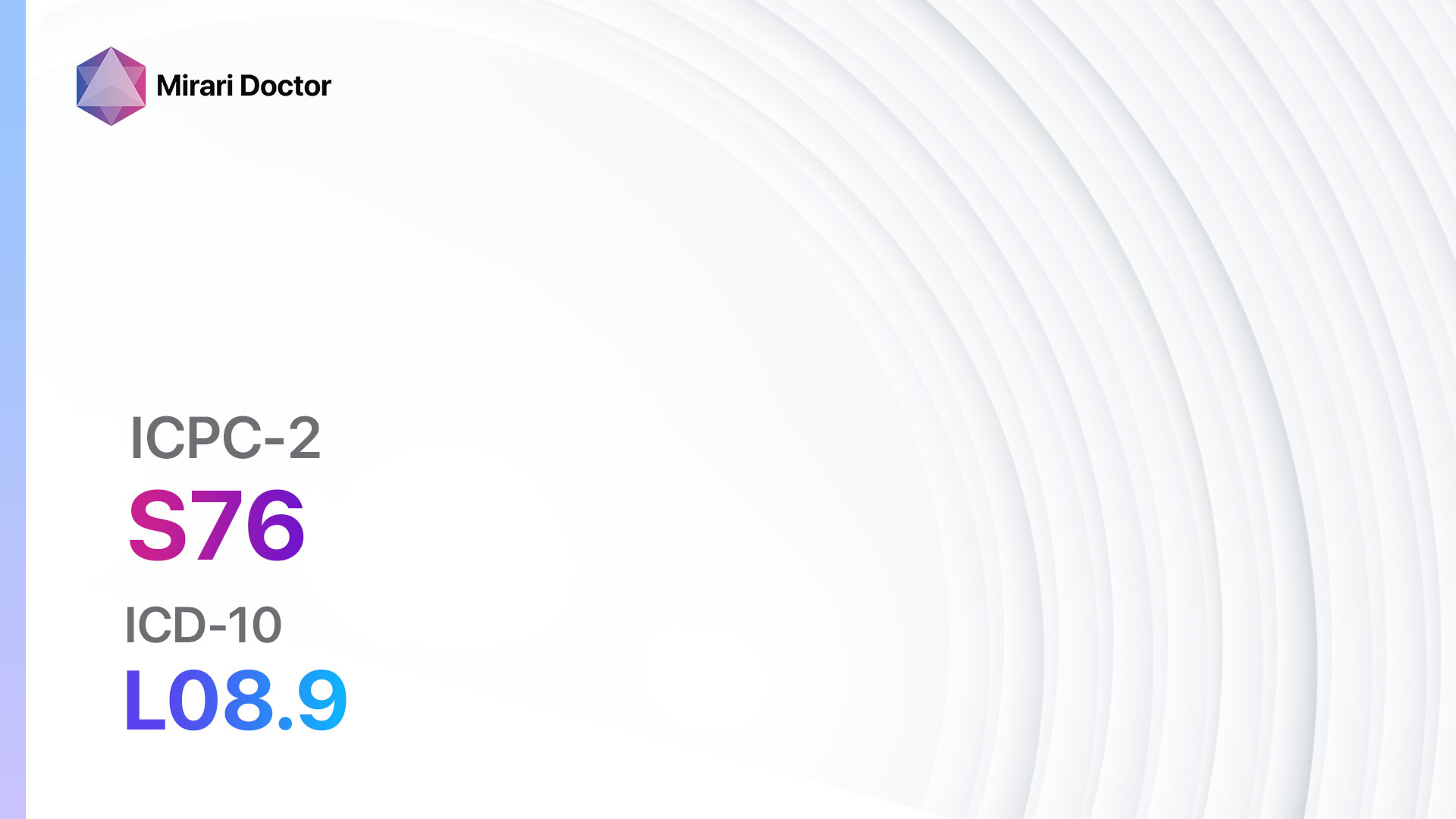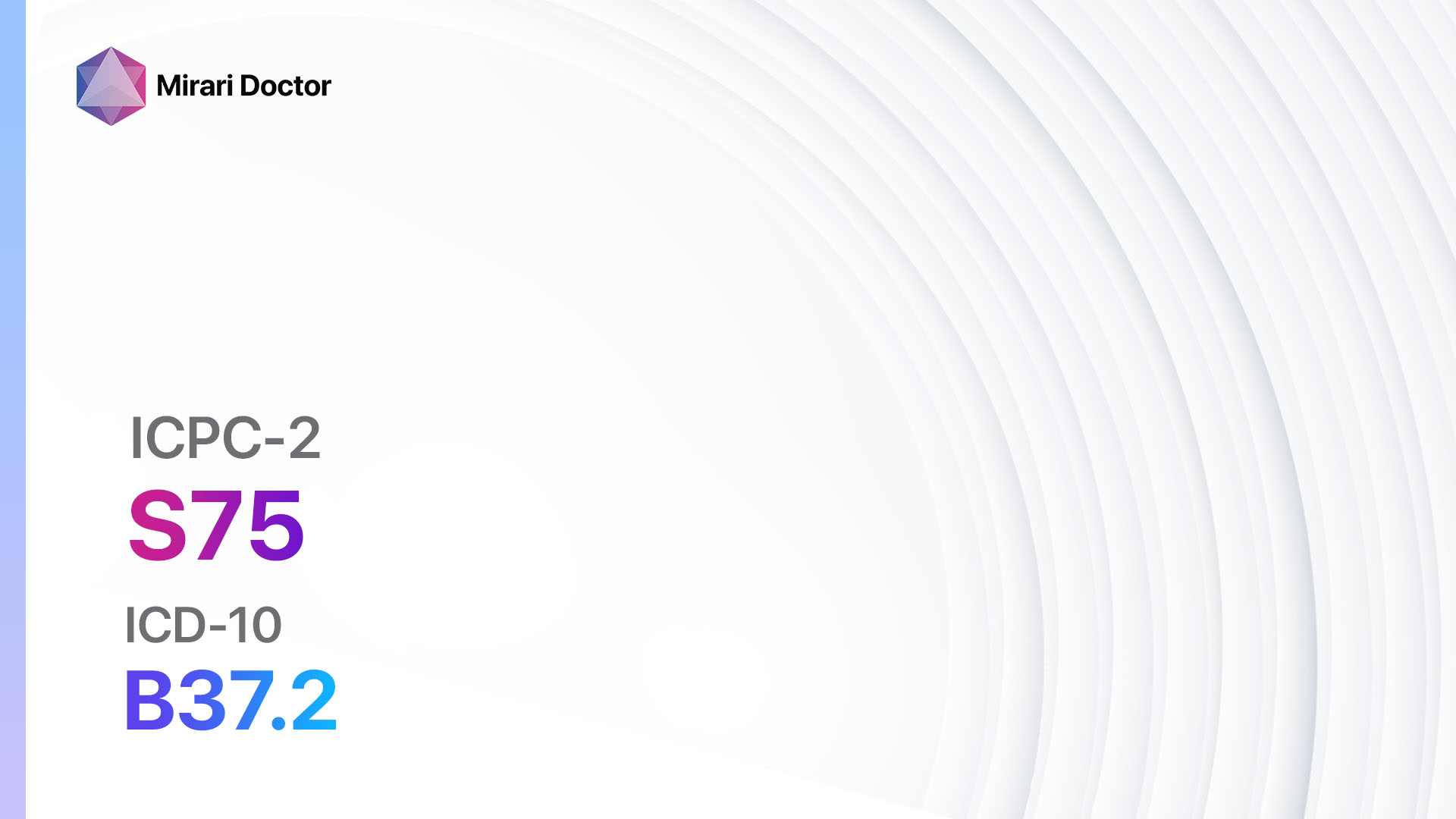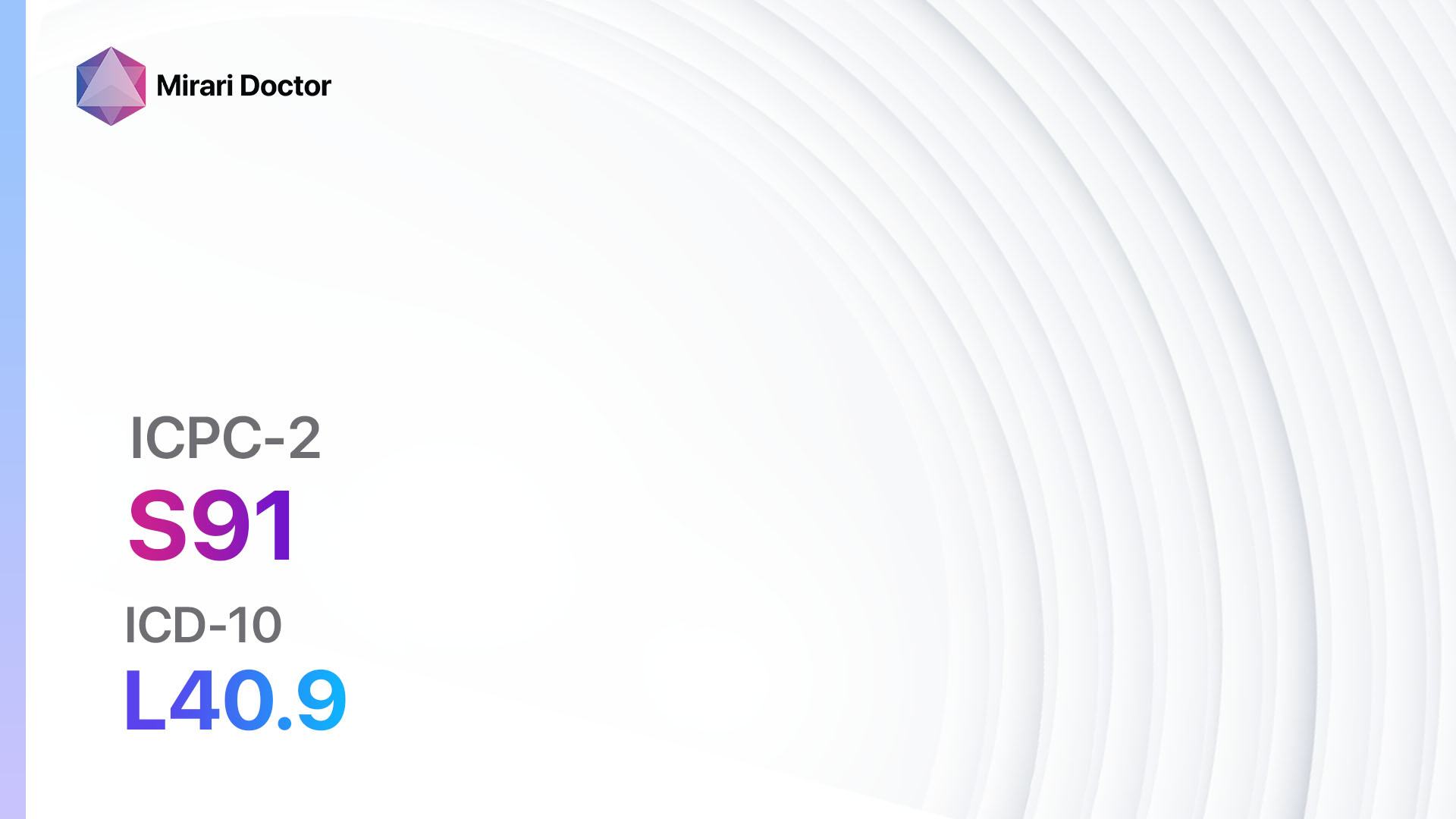
Introduction
Psoriasis is a chronic autoimmune skin condition characterized by the rapid buildup of skin cells, resulting in thick, red, and scaly patches[1]. It affects approximately 2-3% of the global population and can significantly impact a person’s quality of life[2]. The aim of this guide is to provide healthcare professionals with a comprehensive overview of the diagnostic steps, possible interventions, and lifestyle modifications for managing psoriasis.
Codes
Symptoms
- Red patches of skin covered with thick, silvery scales[3]
- Dry, cracked skin that may bleed[4]
- Itching, burning, or soreness[5]
- Thickened, pitted or ridged nails[6]
- Swollen and stiff joints (in some cases)[7]
Causes
- Genetic predisposition[8]
- Immune system dysfunction[9]
- Environmental triggers (such as infections, stress, or certain medications)[10]
Diagnostic Steps
Medical History
- Gather information about the patient’s personal and family medical history
- Identify any risk factors, such as a family history of psoriasis or autoimmune diseases
- Assess the patient’s current medications, as certain drugs can trigger or worsen psoriasis symptoms
- Inquire about the patient’s lifestyle habits, including smoking and alcohol consumption, as these can impact disease severity
Physical Examination
- Examine the skin for characteristic psoriasis lesions, including red patches with silvery scales
- Assess the nails for pitting, ridges, or discoloration
- Evaluate the joints for signs of inflammation or stiffness
- Perform a thorough examination of the scalp, genitals, and other areas commonly affected by psoriasis
Determine Severity
Psoriasis can be classified into different categories based on the severity and extent of skin involvement. The following are the commonly used classifications:
- Mild psoriasis: <3% body surface area (BSA) involvement
- Moderate psoriasis: 3-10% BSA involvement
- Severe psoriasis: >10% BSA involvement or involvement of critical areas (face, hands, feet, genitals)
Laboratory Tests
- Complete blood count (CBC) to assess for anemia or signs of inflammation
- Erythrocyte sedimentation rate (ESR) or C-reactive protein (CRP) to measure the level of inflammation in the body
- Liver function tests (LFTs) to monitor for potential medication-related liver toxicity
- Kidney function tests to evaluate renal function
- Rheumatoid factor and anti-cyclic citrullinated peptide (anti-CCP) antibodies to rule out psoriatic arthritis
Diagnostic Imaging
- X-rays may be used to evaluate joints for signs of psoriatic arthritis
- Ultrasound, CT scans, or MRIs may be ordered to assess the extent of joint or tendon involvement in psoriatic arthritis
Other Tests
- Skin biopsy to confirm the diagnosis and rule out other skin conditions
- Patch testing to identify potential triggers or allergens that may worsen psoriasis symptoms
Follow-up and Patient Education
- Schedule regular follow-up appointments to monitor disease progression and treatment response
- Educate the patient about the chronic nature of psoriasis and the importance of long-term management
- Provide information on self-care measures, such as moisturizing the skin, avoiding triggers, and stress management techniques
- Refer patients to support groups or counseling services to address the emotional impact of living with psoriasis
Possible Interventions
Traditional Interventions
Medications:
Top 5 drugs for Psoriasis:
- Topical corticosteroids (e.g., Betamethasone, Clobetasol):
- Cost: $10-$100 per tube
- Contraindications: Skin infections, open wounds, or hypersensitivity to corticosteroids
- Side effects: Skin thinning, discoloration, or irritation
- Severe side effects: Adrenal suppression (with prolonged use)
- Drug interactions: None significant
- Warning: Avoid long-term use on sensitive areas (face, genitals)
- Topical vitamin D analogs (e.g., Calcipotriene, Calcitriol):
- Cost: $20-$100 per tube
- Contraindications: Hypersensitivity to vitamin D analogs
- Side effects: Skin irritation, itching, or burning
- Severe side effects: None significant
- Drug interactions: None significant
- Warning: Avoid excessive use on large areas of the body
- Topical retinoids (e.g., Tazarotene):
- Cost: $100-$200 per tube
- Contraindications: Pregnancy or hypersensitivity to retinoids
- Side effects: Skin irritation, dryness, or peeling
- Severe side effects: Photosensitivity, birth defects (if used during pregnancy)
- Drug interactions: None significant
- Warning: Use with caution in patients with sensitive skin
- Systemic retinoids (e.g., Acitretin):
- Cost: $500-$1000 per month
- Contraindications: Pregnancy or hypersensitivity to retinoids
- Side effects: Dry skin, dry eyes, or elevated liver enzymes
- Severe side effects: Teratogenicity (avoid pregnancy for at least 3 years after discontinuation)
- Drug interactions: None significant
- Warning: Requires regular monitoring of liver function and lipid levels
- Biologic agents (e.g., Adalimumab, Etanercept):
- Cost: $3000-$5000 per month
- Contraindications: Active infections or malignancies
- Side effects: Injection site reactions, upper respiratory tract infections
- Severe side effects: Increased risk of infections, malignancies, or autoimmune reactions
- Drug interactions: None significant
- Warning: Requires regular monitoring for infections and malignancies
Alternative Drugs:
- Methotrexate: An immunosuppressant used for severe psoriasis not responding to other treatments. Cost: $20-$100 per month.
- Cyclosporine: An immunosuppressant used for severe psoriasis. Cost: $500-$1000 per month.
- Apremilast: An oral medication that inhibits specific enzymes involved in inflammation. Cost: $3000-$5000 per month.
- Ustekinumab: A biologic agent that targets specific proteins involved in psoriasis. Cost: $3000-$5000 per month.
- Secukinumab: A biologic agent that targets specific proteins involved in psoriasis. Cost: $3000-$5000 per month.
Surgical Procedures:
- None applicable for psoriasis
Alternative Interventions
- Acupuncture: May help reduce inflammation and relieve psoriasis symptoms. Cost: $60-$120 per session.
- Fish oil supplements: Omega-3 fatty acids found in fish oil may have anti-inflammatory effects. Cost: $10-$30 per month.
- Aloe vera: Topical application of aloe vera gel may soothe irritated skin. Cost: $5-$20 per bottle.
- Turmeric: Curcumin, the active compound in turmeric, has anti-inflammatory properties. Cost: $5-$20 per bottle.
- Probiotics: Some studies suggest that certain strains of probiotics may help improve psoriasis symptoms. Cost: $10-$50 per month.
Lifestyle Interventions
- Moisturize regularly: Apply a moisturizer to keep the skin hydrated and prevent dryness. Cost: $5-$20 per bottle.
- Avoid triggers: Identify and avoid triggers that worsen psoriasis symptoms, such as stress, certain foods, or skin injuries.
- Manage stress: Practice stress management techniques, such as meditation, yoga, or deep breathing exercises. Cost: Varies (free to join classes or purchase instructional materials).
- Maintain a healthy weight: Obesity can worsen psoriasis symptoms, so maintaining a healthy weight through diet and exercise is important. Cost: Varies (cost of healthy food choices and gym memberships, if applicable).
- Quit smoking: Smoking can exacerbate psoriasis symptoms, so quitting smoking is highly recommended. Cost: Varies (cost of smoking cessation aids or programs).
It is important to note that the cost ranges provided are approximate and may vary depending on the location and availability of the interventions.
Mirari Cold Plasma Alternative Intervention
Understanding Mirari Cold Plasma
- Safe and Non-Invasive Treatment: Mirari Cold Plasma is a safe and non-invasive treatment option for various skin conditions. It does not require incisions, minimizing the risk of scarring, bleeding, or tissue damage.
- Efficient Extraction of Foreign Bodies: Mirari Cold Plasma facilitates the removal of foreign bodies from the skin by degrading and dissociating organic matter, allowing easier access and extraction.
- Pain Reduction and Comfort: Mirari Cold Plasma has a local analgesic effect, providing pain relief during the treatment, making it more comfortable for the patient.
- Reduced Risk of Infection: Mirari Cold Plasma has antimicrobial properties, effectively killing bacteria and reducing the risk of infection.
- Accelerated Healing and Minimal Scarring: Mirari Cold Plasma stimulates wound healing and tissue regeneration, reducing healing time and minimizing the formation of scars.
Mirari Cold Plasma Prescription
Video instructions for using Mirari Cold Plasma Device – S91 Psoriasis (ICD-10:L40.9)
| Mild | Moderate | Severe |
| Mode setting: 1 (Infection) Location: 0 (Localized) Morning: 15 minutes, Evening: 15 minutes |
Mode setting: 1 (Infection) Location: 0 (Localized) Morning: 30 minutes, Lunch: 30 minutes, Evening: 30 minutes |
Mode setting: 1 (Infection) Location: 0 (Localized) Morning: 30 minutes, Lunch: 30 minutes, Evening: 30 minutes |
| Mode setting: 2 (Wound Healing) Location: 0 (Localized) Morning: 15 minutes, Evening: 15 minutes |
Mode setting: 2 (Wound Healing) Location: 0 (Localized) Morning: 30 minutes, Lunch: 30 minutes, Evening: 30 minutes |
Mode setting: 2 (Wound Healing) Location: 0 (Localized) Morning: 30 minutes, Lunch: 30 minutes, Evening: 30 minutes |
| Mode setting: 3 (Antiviral Therapy) Location: 0 (Localized) Morning: 15 minutes, Evening: 15 minutes |
Mode setting: 3 (Antiviral Therapy) Location: 0 (Localized) Morning: 30 minutes, Lunch: 30 minutes, Evening: 30 minutes |
Mode setting: 3 (Antiviral Therapy) Location: 0 (Localized) Morning: 30 minutes, Lunch: 30 minutes, Evening: 30 minutes |
| Total Morning: 45 minutes approx. $7.50 USD, Evening: 45 minutes approx. $7.50 USD |
Total Morning: 90 minutes approx. $15 USD, Lunch: 90 minutes approx. $15 USD, Evening: 90 minutes approx. $15 USD |
Total Morning: 90 minutes approx. $15 USD, Lunch: 90 minutes approx. $15 USD, Evening: 90 minutes approx. $15 USD |
| Usual treatment for 7-60 days approx. $105 USD – $900 USD | Usual treatment for 6-8 weeks approx. $1,890 USD – $2,520 USD | Usual treatment for 3-6 months approx. $4,050 USD – $8,100 USD |
 |
|
Use the Mirari Cold Plasma device to treat Psoriasis effectively.
WARNING: MIRARI COLD PLASMA IS DESIGNED FOR THE HUMAN BODY WITHOUT ANY ARTIFICIAL OR THIRD PARTY PRODUCTS. USE OF OTHER PRODUCTS IN COMBINATION WITH MIRARI COLD PLASMA MAY CAUSE UNPREDICTABLE EFFECTS, HARM OR INJURY. PLEASE CONSULT A MEDICAL PROFESSIONAL BEFORE COMBINING ANY OTHER PRODUCTS WITH USE OF MIRARI.
Step 1: Cleanse the Skin
- Start by cleaning the affected area of the skin with a gentle cleanser or mild soap and water. Gently pat the area dry with a clean towel.
Step 2: Prepare the Mirari Cold Plasma device
- Ensure that the Mirari Cold Plasma device is fully charged or has fresh batteries as per the manufacturer’s instructions. Make sure the device is clean and in good working condition.
- Switch on the Mirari device using the power button or by following the specific instructions provided with the device.
- Some Mirari devices may have adjustable settings for intensity or treatment duration. Follow the manufacturer’s instructions to select the appropriate settings based on your needs and the recommended guidelines.
Step 3: Apply the Device
- Place the Mirari device in direct contact with the affected area of the skin. Gently glide or hold the device over the skin surface, ensuring even coverage of the area experiencing.
- Slowly move the Mirari device in a circular motion or follow a specific pattern as indicated in the user manual. This helps ensure thorough treatment coverage.
Step 4: Monitor and Assess:
- Keep track of your progress and evaluate the effectiveness of the Mirari device in managing your Psoriasis. If you have any concerns or notice any adverse reactions, consult with your health care professional.
Note
This guide is for informational purposes only and should not replace the advice of a medical professional. Always consult with your healthcare provider or a qualified medical professional for personal advice, diagnosis, or treatment. Do not solely rely on the information presented here for decisions about your health. Use of this information is at your own risk. The authors of this guide, nor any associated entities or platforms, are not responsible for any potential adverse effects or outcomes based on the content.
Mirari Cold Plasma System Disclaimer
- Purpose: The Mirari Cold Plasma System is a Class 2 medical device designed for use by trained healthcare professionals. It is registered for use in Thailand and Vietnam. It is not intended for use outside of these locations.
- Informational Use: The content and information provided with the device are for educational and informational purposes only. They are not a substitute for professional medical advice or care.
- Variable Outcomes: While the device is approved for specific uses, individual outcomes can differ. We do not assert or guarantee specific medical outcomes.
- Consultation: Prior to utilizing the device or making decisions based on its content, it is essential to consult with a Certified Mirari Tele-Therapist and your medical healthcare provider regarding specific protocols.
- Liability: By using this device, users are acknowledging and accepting all potential risks. Neither the manufacturer nor the distributor will be held accountable for any adverse reactions, injuries, or damages stemming from its use.
- Geographical Availability: This device has received approval for designated purposes by the Thai and Vietnam FDA. As of now, outside of Thailand and Vietnam, the Mirari Cold Plasma System is not available for purchase or use.
References
- Boehncke WH, Schön MP. Psoriasis. Lancet. 2015;386(9997):983-994.
- Parisi R, Symmons DP, Griffiths CE, Ashcroft DM. Global epidemiology of psoriasis: a systematic review of incidence and prevalence. J Invest Dermatol. 2013;133(2):377-385.
- Nestle FO, Kaplan DH, Barker J. Psoriasis. N Engl J Med. 2009;361(5):496-509.
- Griffiths CE, Barker JN. Pathogenesis and clinical features of psoriasis. Lancet. 2007;370(9583):263-271.
- Lebwohl M. Psoriasis. Ann Intern Med. 2018;168(7):ITC49-ITC64.
- Jiaravuthisan MM, Sasseville D, Vender RB, Murphy F, Muhn CY. Psoriasis of the nail: anatomy, pathology, clinical presentation, and a review of the literature on therapy. J Am Acad Dermatol. 2007;57(1):1-27.
- Gladman DD, Antoni C, Mease P, Clegg DO, Nash P. Psoriatic arthritis: epidemiology, clinical features, course, and outcome. Ann Rheum Dis. 2005;64 Suppl 2:ii14-ii17.
- Elder JT, Bruce AT, Gudjonsson JE, et al. Molecular dissection of psoriasis: integrating genetics and biology. J Invest Dermatol. 2010;130(5):1213-1226.
- Lowes MA, Suárez-Fariñas M, Krueger JG. Immunology of psoriasis. Annu Rev Immunol. 2014;32:227-255.
- Dika E, Bardazzi F, Balestri R, Maibach HI. Environmental factors and psoriasis. Curr Probl Dermatol. 2007;35:118-135.
Related articles
Made in USA



